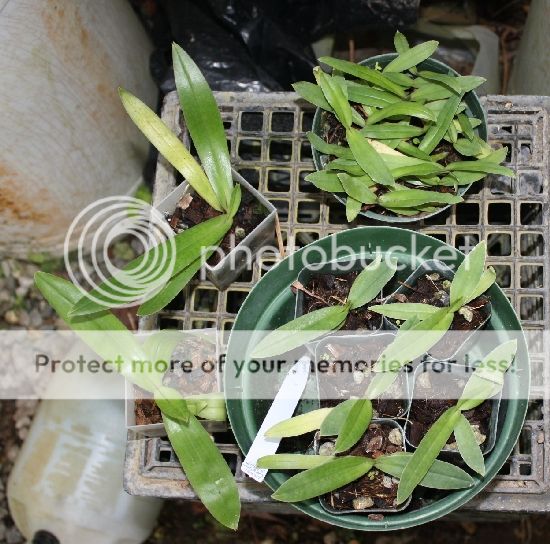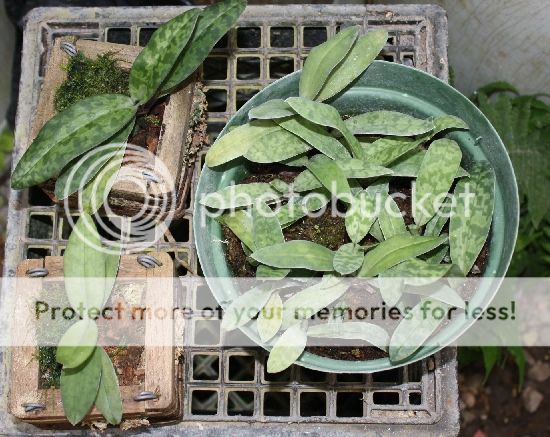I stopped reading that thread with so much confusion. lol
... but I'm just a simple guy who mixes locally bought liquid concentrate fertilizer with my tap water.
That's a good way to get healthy Paphs and be a happy non confused Paph lover

I stopped reading that thread with so much confusion. lol
... but I'm just a simple guy who mixes locally bought liquid concentrate fertilizer with my tap water.
I stopped reading that thread with so much confusion. lol
I'll go see again, but I'm just a simple guy who mixes locally bought liquid concentrate fertilizer with my tap water.

That's a good way to get healthy Paphs and be a happy non confused Paph lover
Then I'd suggest doing 1/10th the rate you are presently doing and see what happens.:wink:











These seedlings all come from the same flask. They represent the largest (middle back is in low bud) and the smallest. They have all had the same growing conditions. I'll probably discard the smaller ones.
Thanks!
Do you use tap water in German? hard water, yeah?


This - exactly.

Spicerianum seedlings

Wardii seedlings
Both out of flask about March 2013.
Not much size variation among the spicerianum seedlings except for those pulled out of the compot into individual pots.
The wardii have much wider variation in size. But also looking at leaf color there's a lot of variation too. I pulled out the nicest dark leaf and pale leaf versions. The dark leaf has grown a lot more than the pale leaf version.
So in these two groups of plants there may be a lot more genetic predilection for size variants in the wardii, but not for the spicerianum.
Those look so cute and so nice!
That largest wardii plant has very beautifully marked leaves.
So, what do you feed them?
just a simple version without making my head spin. :wink:
Those look so cute and so nice!
That largest wardii plant has very beautifully marked leaves.
They get splashed daily with a weak solution of K lite, my Mg/PO4/SO4 solution and diluted well water.
N is about 5ppm so if 1/2 tsp per gal was 80 to 100 ppm N, then down to the equivalent of 1/32 to 1/40th of a tsp of dry K-lite. Since I don't have measuring spoons that small I make up a more concentrated stock and dip out a tablespoon/gallon.
So what is the N per teaspoon/gal of your fert of choice?
If you use 1/4 tsp/gallon then try 1/4 tsp per 5 or 10 gallons.
But also getting back to your original point of big and little babies, that big dark plant wasn't pulled out of the compot because it was the biggest, but because it had the darkest foliage. Same for the other extreme light plant. Before going into the individual baskets they were about average for the larger plants in the compot at the time.
Going into the baskets they are growing faster than the ones left behind in the compot.
This is probably more obvious for the spicerianums. The two I pulled out weren't obviously the biggest, but I found 2 nice ones that had the most basal leaf pigmentation. The reason they are so much bigger now compared to the ones still in the compot would be due to cultural differences rather than genetic differences.
In years past I could only count on a small percentage of really good doers to move out of compot and a bunch of stumpies. However, even moving into their own pots wouldn't necessarily improve their odds, in fact I'd end up with more losses as they came out of compot, than just leaving them in compot.
So after 3 or so years I'd generally end up with all the stumpies anyway while most of the faster growing ones would crap out from the individual attention.
I use 7-5-6 fertilizer at the moment. I use a little less than 1/4 tsp per gallon.
I use 7-5-6 fertilizer at the moment. I use a little less than 1/4 tsp per gallon.
By the way, Mg/PO4/SO4, do you add PO4 to Epsom Salt??
I also have Epsom Salt, which I have only used about twice, but the package is still sitting around somewhere.
What are your seedlings potted that they are ok being watered daily and not rot out??
I wonder if it's the crowing, then?
I read that certain plants may release chemicals to attack others, sometimes even those of the same species.
Or just the more space allows each plant to do better?
I see this all the time when I used to garden with annuals.
The more space they got, the bigger the plants became compared to the ones that were planted too close to one another.
In the compot, I always have a few that are much bigger than the rest no matter what. This might be genetic, right?
I use 7-5-6 fertilizer at the moment. I use a little less than 1/4 tsp per gallon.
Enter your email address to join: